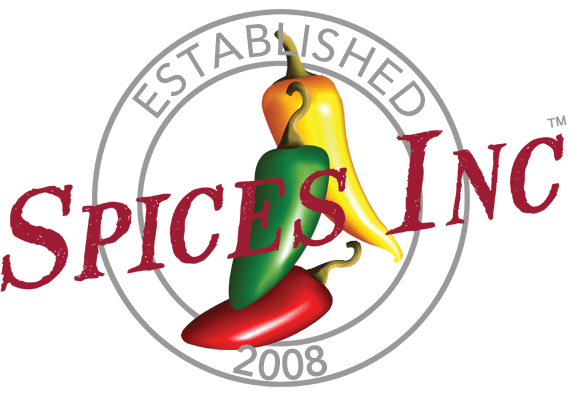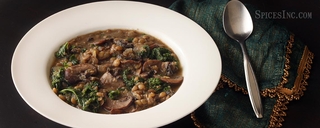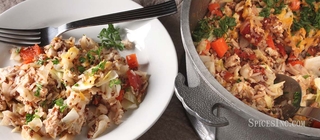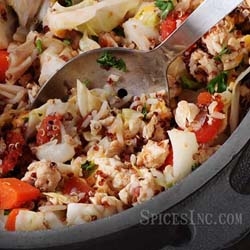Organic Thyme Leaf
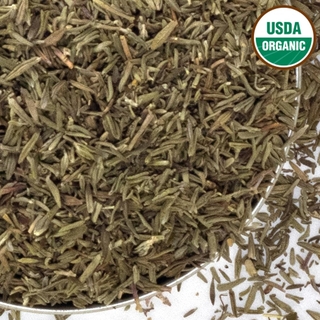
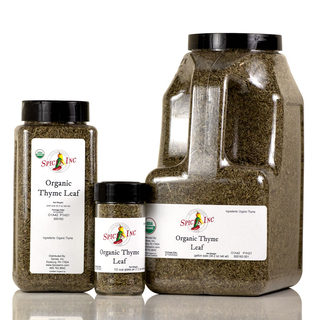


Organic Thyme Leaf
Organic Thyme Leaf, Thymus vulgaris, is a fragrant perennial native to the southern Mediterranean coast. It is also known as organic thyme, organic thyme leaves, or organic dried thyme. It has an essential oil content of 1.5-2% by weight.
Thyme has been used as both a culinary and medicinal herb throughout history. The first documented appearance of thyme can be traced back to the Ancient Egyptians where it was used as an embalming agent for preserving pharaohs. Thyme oil has also been used as an antiseptic both in mouthwash and as a topical application since the 1500s.
Organic Thyme Leaf is popular with seasoning companies, Mediterranean restaurants, cafes, food trucks, and spice and olive oil shops.
Flavor Profile
Organic Thyme Leaf tastes spicy and piney with clove and mint undertones.
How to Use
Thyme is popular in many European cuisines. The French use it liberally in sauces, soups, stews, and vinegars. In the US, it is a central flavoring in New England clam chowder, turkey stuffing, and sausage. It’s a must-have in this rich Provencal Chicken. It adds a great, herbaceous element to these Spiced Almonds. Elevate a simple weeknight meal by stirring Organic Thyme Leaf into Ground Turkey and Cabbage Casserole. Organic Thyme Leaf pairs well in soups and stew like this hearty Creamy Lentil Stew with Mushrooms and Kale. Stir it into omelets, frittatas, and quiches for an added intense flavor.
Thyme works well with allspice, bay leaf, basil, chili powder, garlic, marjoram, nutmeg, oregano, paprika and parsley. Add to beef, egg and cheese dishes, cabbage, carrots, chicken, figs, fish, goat cheese, lamb, leeks, legumes, lentils, onions, peas, pork, potatoes, soups, tomatoes and venison.
| Also Called | Organic thyme, organic thyme leaves, or organic dried thyme |
| Species | Thymus vulgaris |
| Ingredients | Dried organic thyme leaf |
| Flavor Profile | Spicy and piney with clove and mint undertones |
| Oil content | 1.5-2% |
| Recommended Uses | Stuffing, sausage, soups, stews, meats, vegetarian dishes |
| Cuisine | Mediterranean, Spanish, French, American |
| How To Store | Airtight container in a cool, dark place |
| Shelf Life | 6-12 months |
| Country of Origin | Egypt |
Nutrition Facts
Serving Size1 tsp
Amount Per Serving
Calories1
% Daily Value*
Total Fat0g0%
Saturated Fat0g0%
Trans Fat0g
Polyunsaturated Fat0g
Monounsaturated Fat0g
Cholesterol0mg0%
Sodium0.3mg0%
Total Carbohydrate0.3g0%
Dietary Fiber0.2g1%
Total Sugars0.0g
Added Sugars0g0%
Sugar Alcohol0.0g
Protein0.0g0%
Vitamin D0mcg0%
Calcium0mg0%
Iron0mg0%
Potassium0mg0%
*The % Daily Value (DV) tells you how much a nutrient in a serving of food contributes to a daily diet. 2,000 calories a day is used for general nutrition advice. These values were calculated and therefore are approximate. For more accuracy, testing is advised.
